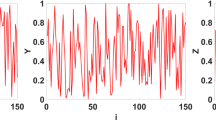Abstract
This paper, presents a novel chaos-based image steganography algorithm. Because of efficient property of chaos based security systems besides steganography applicability in providing secure communication, chaos based steganography algorithms served as a hot topic in recent researches. The proposed scheme possess novelties and advantageous such as: 1) Introducing a novel 3-dimensional chaotic map (LCA map) with strong chaotic characteristics and maximum Lyapunov exponent 20.58, which is used for generating three chaotic sequences, each of them represents the number of row, column, and colour component, respectively. 2) Utilizing random selection procedure for selecting subsequences with length of 2L, which L is the length of secret message 3) Specifying L pairs of triples host positions for embedding LSBs and MSBs of secret message by using three high level chaotic maps. 4) Entering some parameters dependent on elementary initial values, host image, and secret message features as a key point for adding additional layer of security alongside providing high sensitivity. 5) Providing high capacity for embedding secret message, which is equal to 50 % of whole image capacity (M × N × 12). The proposed method could be applied in different criterion such as, confidential communication and data storing, protection of data alteration, and etc. Our experimental results guarantees that our scheme is not only robust against differential attacks, but also has promising results such as highly sensitive keys, Quality index, PSNR, MSE, and hiding capacity as shown in statistical security analysis.








Similar content being viewed by others
References
Alam S, Kumar V, Siddiqui W, Ahmad M (2014) Key dependent image steganography using edge detection. In: Advanced Computing & Communication Technologies (ACCT), 2014 Fourth International Conference on. IEEE, pp 85–88
Alam S, Kumar V, Siddiqui WA, Ahmad M (2014) Key dependent image steganography using edge detection. In: Advanced Computing & Communication Technologies (ACCT), 2014 Fourth International Conference on. IEEE, pp 85–88
Anees A et al (2014) A technique for digital steganography using chaotic maps. Nonlinear Dyn 75(4):807–816
Arshad H, Nikooghadam M (2014) Three-factor anonymous authentication and key agreement scheme for telecare medicine information systems. J Med Syst 38(12):1–12
Arshad H, Nikooghadam M (2015) Security analysis and improvement of two authentication and key agreement schemes for session initiation protocol. J Supercomput 71(8):3163–3180
Arshad H, Nikooghadam M (2016) An efficient and secure authentication and key agreement scheme for session initiation protocol using ECC. Multimed Tools Appl 75(1):181–197
Arshad H, Teymoori V, Nikooghadam M, Abbassi H (2015) On the security of a two-factor authentication and key agreement scheme for telecare medicine information systems. J Med Syst 39(8):1–10
Aziz M, Tayarani-N MH, Afsar M (2015) A cycling chaos-based cryptic-free algorithm for image steganography. Nonlinear Dyn 80(3):1271–1290
Bandyopadhyay D, Dasgupta K, Mandal JK, Dutta P (2014) A novel secure image steganography method based on chaos theory in spatial domain. Int J Secur Priv Trust Manag (IJSPTM) 3(1):11–22
Bilal M, Imtiaz S, Abdul W, Ghouzali S, Asif S (2014) Chaos based Zero-steganography algorithm. Multimed Tools Appl 72(2):1073–1092
Das P, Kar N (2014) A DNA based image steganography using 2D chaotic map. In: Electronics and Communication Systems (ICECS), 2014 International Conference on. IEEE, pp 1–5
Ghebleh M, Kanso A (2014) A robust chaotic algorithm for digital image steganography. Commun Nonlinear Sci Numer Simul 19(6):1898–1907
Johnson NF, Jajodia S (1998) Exploring steganography: seeing the unseen. Computer 31(2):26–34
Judge J (2001) Steganography: past, present, future. SANS white paper
Kanso A, Own HS (2012) Steganographic algorithm based on a chaotic map. Commun Nonlinear Sci Numer Simul 17(8):3287–3302
Mollaeefar M, Sharif A, Nazari M (2015) A novel encryption scheme for colored image based on high level chaotic maps. Multimedia Tools Appl 1–23
Potdar VM, Han S, Chang E (2005) Fingerprinted secret sharing steganography for robustness against image cropping attacks. In: Industrial Informatics, 2005. INDIN’05. 2005 3rd IEEE International Conference on. IEEE, pp 717–724
Provos N, Honeyman P (2003) Hide and seek: an introduction to steganography. IEEE Secur Priv 1(3):32–44
Provos N, Honeyman P (2001) Detecting steganographic content on the internet. Center for Information Technology Integration
Roy R, Sarkar A, Changder S (2013) Chaos based edge adaptive image steganography. Procedia Technol 10:138–146
Sabery KM, Yaghoobi M (2008) A simple and robust approach for image hiding using chaotic logistic map. In Advanced Computer Theory and Engineering, 2008. ICACTE’08. International Conference on. IEEE, pp 623–627
Shirali-Shahreza MH, Shirali-Shahreza M (2006) A new approach to Persian/Arabic text steganography. In: Computer and Information Science, 2006 and 2006 1st IEEE/ACIS International Workshop on Component-Based Software Engineering, Software Architecture and Reuse. ICIS-COMSAR 2006. 5th IEEE/ACIS International Conference on. IEEE, pp 310–315
Subhedar MS, Mankar VH (2014) Current status and key issues in image steganography: a survey. Comput Sci Rev 13:95–113
Wang Z, Bovik AC (2002) A universal image quality index. IEEE Signal Process Lett 9(3):81–84
Author information
Authors and Affiliations
Corresponding author
Rights and permissions
About this article
Cite this article
Sharif, A., Mollaeefar, M. & Nazari, M. A novel method for digital image steganography based on a new three-dimensional chaotic map. Multimed Tools Appl 76, 7849–7867 (2017). https://doi.org/10.1007/s11042-016-3398-y
Received:
Revised:
Accepted:
Published:
Issue Date:
DOI: https://doi.org/10.1007/s11042-016-3398-y




